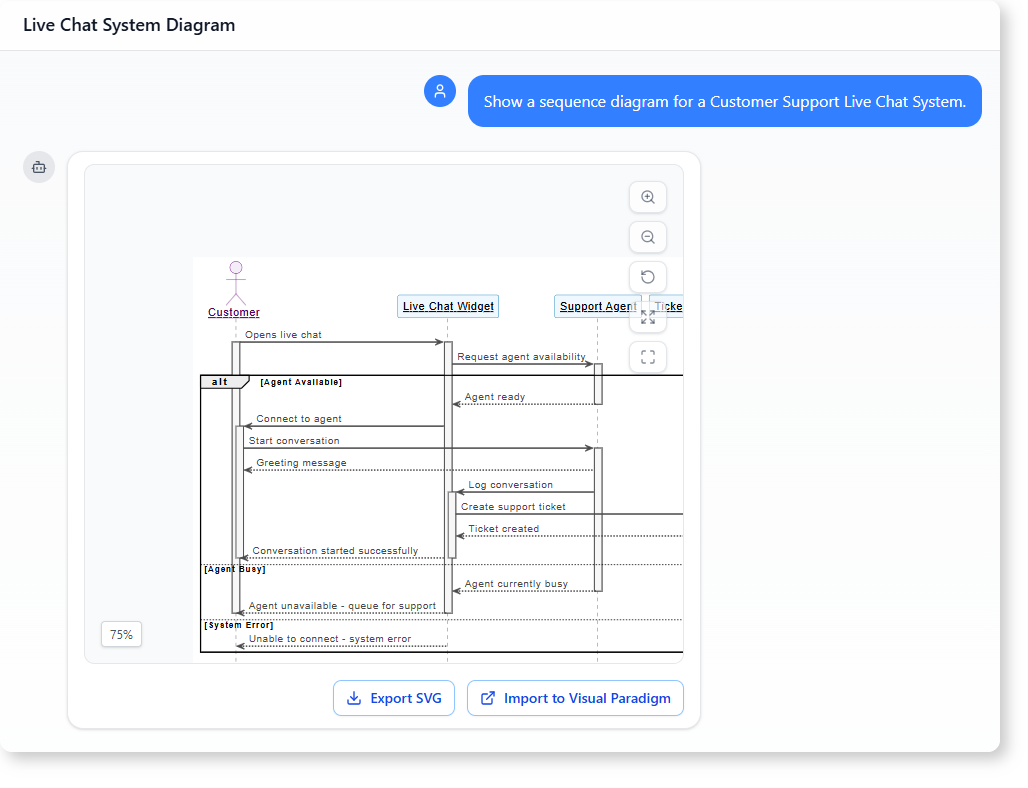Now Reading: How AI-Powered Modeling Software Builds a Live Chat Support System
-
01
How AI-Powered Modeling Software Builds a Live Chat Support System
How AI-Powered Modeling Software Builds a Live Chat Support System
How AI-Powered Modeling Software Builds a Live Chat Support System
Imagine a customer trying to reach support. They open a live chat widget, wait, and either connect with an agent or are placed in a queue. How does this flow work?
With AI-Powered Modeling Software, you don’t have to guess. You describe the process, and the AI generates a clear, accurate sequence diagram—complete with step-by-step explanations.
This isn’t just theory. It’s a real-world use case where a user asked for a visualization of a customer support live chat system. The result? A clean, readable sequence diagram that shows every interaction, from the customer opening the chat to the system logging the conversation and creating a support ticket.

Why This Matters for Businesses
Support teams are under pressure. Customers expect fast, reliable help. A clear workflow reduces confusion and improves training.
A live chat system isn’t just about connecting users to agents. It’s about managing availability, handling queues, and ensuring every conversation is recorded. Without a visual model, these steps get lost in meetings or spreadsheets.
That’s where AI-Powered Modeling Software steps in. It turns natural language into a structured diagram—turning vague ideas into something tangible.
The User’s Journey: From Idea to Diagram
The user was a product manager responsible for improving customer support. Their team had a live chat system in place, but there was no shared understanding of how it worked.
They needed to explain the system to new staff. They wanted a simple, visual breakdown of the flow—something they could show in onboarding sessions.
Instead of drawing it by hand or writing out every step, they asked the AI-Powered Modeling Software to generate a sequence diagram for a live chat system.
Here’s what happened:
- The user typed: “Show a sequence diagram for a Customer Support Live Chat System.“
The AI instantly created a detailed sequence diagram showing the full interaction between the customer, the chat widget, the support agent, and the ticketing system.
- Next, they asked: “Explain the step-by-step process represented in the sequence diagram in plain language.“
The AI didn’t just show the flow. It broke it down into everyday words—no technical jargon. It explained what happens when the agent is available, when they’re busy, and what happens in case of a system error.
What the AI-Powered Modeling Software Delivers
The output wasn’t just a picture. It was a complete workflow, clearly structured:
- The customer opens the live chat widget.
- The widget checks if a support agent is available.
- If the agent is free, the system connects the user and starts the conversation.
- The agent greets the customer and logs the session.
- A support ticket is created automatically.
- If the agent is busy, the user is notified and added to a queue.
- In case of a system error, the user is informed and the connection fails.
Each step is labeled, clearly separated, and written in a way that anyone can understand—no prior modeling knowledge needed.
Why This Is Better Than Traditional Tools
Most modeling tools require users to learn syntax or templates. You have to choose a diagram type, drag components, and manually define interactions.
With AI-Powered Modeling Software, you just describe the scenario. The tool handles the complexity.
This means:
- Less time spent on setup
- No need to remember diagram conventions
- Immediate clarity for stakeholders
It’s not about replacing traditional tools. It’s about simplifying the process for people who need to understand or explain a system.
How This Helps Teams Collaborate
When support teams need to onboard new members, training materials can be built from actual workflows. Instead of relying on videos or PDFs, they can refer to a live, interactive flow that shows every action.
This is especially helpful during product reviews or system updates. Teams can quickly see how changes might affect the user experience.
Real-World Impact
A team using this AI-Powered Modeling Software reported that onboarding new support staff dropped from 3 days to under 12 hours. The clarity of the workflow helped reduce miscommunication and errors.
It’s not about automation. It’s about making understanding easy.
FAQ
Q: Can AI-Powered Modeling Software generate a sequence diagram for a live chat system?
A: Yes. Simply describe the system in plain language. The AI generates a detailed sequence diagram showing each step—from customer initiation to agent connection and ticket creation.
Q: Does the AI explain the process in simple terms?
A: Absolutely. After generating the diagram, the AI provides a step-by-step explanation in everyday language, making it accessible to non-technical staff.
Q: Is this AI tool useful for workflow analysis in real-time?
A: While it’s designed for modeling and explanation, the insights from a live chat system workflow can be used to identify bottlenecks or areas for improvement in support operations.
Q: How does the AI know what to include in the sequence diagram?
A: It learns from natural language prompts. When you describe a system or process, it maps out the key participants, interactions, and conditions—like availability, queues, and errors.
Ready to map out your system’s interactions? Give our AI-powered modeling software a try at Visual Paradigm’s AI Chatbot today!}
